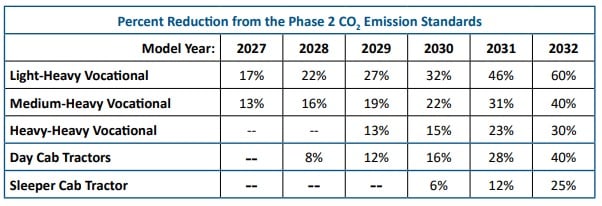What New EPA Standards Mean for Fleets
In March of this year, the Environmental Protection Agency (EPA) published a final rule: “Greenhouse Gas Emissions Standards for Heavy Duty Vehicles – Phase 3.” The final rule establishes stricter standards on emissions from heavy-duty vehicles (vocational vehicles and tractors) starting with the 2027 model year, and will be phased in over five years. Below, we dive into what this means for fleets going forward and how transportation companies can adapt to this change.
Understanding the Phase 3 Standards
These standards are the final part of EPA’s Clean Trucks Plan, which also include EPA’s recently finalized light and medium duty vehicles final rule for MY 2027-2032 (passenger cars and Class 2B and 3 trucks) and its heavy-duty NOx final rule.
The Phase 3 standards vary by vehicle type and are up to 40 to 60 percent stronger than EPA’s phase 2 standards. The standards are designed to be performance-based and allow for manufacturers to choose what solutions they provide to their customers, which can include a range of options to include advanced internal combustion engines, hybrid vehicles, plug-in electric hybrid vehicles, battery electric vehicles and hydrogen fuel cell vehicles.

The EPA announcement comes on the heels of a March 2024 announcement of the National Zero-Emission Freight Corridor Strategy by the Biden Administration’s Joint Office of Energy and Transportation. The strategy provides guidance on the deployment of zero-emission medium- and heavy-duty vehicle charging and hydrogen fueling infrastructure from 2024 to 2040.
This announcement was paired with the Federal Highway announcing it is designated National EV Corridors to identify short and long term needs and locations for EV charging infrastructure to support goods movement on major highways, the National Freight Highway Network and other critical freight locations such as ports, intermodal centers and warehousing locations.
The Impact of the New Standards
The EPA estimates that the Phase 3 standards will prevent 1 billion tons of greenhouse gas emissions over the next three decades, and buyers of these vehicles will get a payback on their investment in two to five years. EPA also noted that the final standards will reduce air pollution for the 72 million people who live near major truck freight routes who bear a disproportionate burden of exposure to higher pollution levels. The Agency received more than 175,000 comments on the proposed rule when it was announced last year.
The Phase 3 rules have received mixed reactions, with organizations representing fleets pushing back hard on these changes, and manufacturers largely supporting them. While the rules place the compliance burden on the manufacturers, trucking companies will bear the brunt of the changes as manufacturers will most likely pass their costs on to their customers.
The trucking industry maintains that it has made significant reductions over the last few decades in reducing emissions, and these new rules place unrealistic timelines for the industry to meet, noting that there is a significant focus on battery electric vehicles and the current state of zero-emission technology, lack of charging infrastructure and power grid restrictions – issues outside of the control of the industry -- limit its ability to comply within the specified timeframes.
The Clean Freight Coalition noted that these new rules will reduce the payload of trucks and will require more trucks to haul the same amount of freight, and recently released a study indicating that fully electrifying the country’s medium and heavy-duty commercial vehicles will cost motor carriers $620 billion in charging infrastructure, will increase the cost of vehicles by 2-3 times compared to diesel and will require government investment of $370 billion in infrastructure upgrades to their networks and the power grid.
How Trimble Can Help
We’re dedicated to helping transportation companies realize new efficiencies and meet their sustainability goals. We offer several solutions that can assist in optimizing your operation and fleet performance, including:
- VNomics True Fuel – True Fuel software uses real-time in-cab driver coaching, automated reporting and simple performance metrics to help fleets reduce fuel expense by improving driver fuel efficiency.
- Trimble Appian – The Appian suite of route optimization and dispatch software is designed to help private fleets and dedicated carriers better plan and streamline operations.
- Trimble CoPilot – The premier commercial navigation app, CoPilot reduces empty miles by providing drivers the safest, most efficient routes possible.
To speak with us about how we can help your business adapt to changing regulations, contact our team.
About the Author
Stephen A. Keppler - Co-Director, Scopelitis
This piece was produced in collaboration with Stephen Keppler, Co-Director of Scopelitis Transportation Consulting LLC. Stephen has more than 30 years of transportation industry experience, including time as an investigator, inspector and policymaker for the Federal Highway Administration’s Office of Motor Carriers (predecessor to the FMCSA). He has also held executive leadership positions at the Intelligent Transportation Society of America, the Commercial Vehicle Safety Alliance and the Intermodal Association of North America. Follow him on LinkedIn or get in touch at skeppler@scopelitisconsulting.com.
